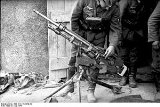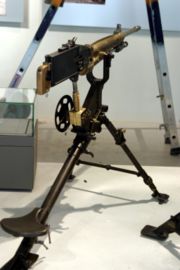
St. Étienne Mle 1907
Encyclopedia

Machine gun
A machine gun is a fully automatic mounted or portable firearm, usually designed to fire rounds in quick succession from an ammunition belt or large-capacity magazine, typically at a rate of several hundred rounds per minute....
which was widely used in the early years of the First World War. It was not derived from the Hotchkiss machine gun, as often stated erroneously, but was instead a distinctly different mechanical design. The St.Etienne Mle 1907 machine gun had circumvented the Hotchkiss patents of 1900 by using a blow-forward gas piston (the Hotchkiss piston blows back as in all modern gas-operated machine guns), a complex rack and pinion system and a fundamentally different bolt mechanism. Those were all inherited from the Puteaux M1905 machine gun.
History
Around the turn of the century the French military evaluated machine guns made by the private French firm of Hotchkiss et CieHotchkiss et Cie
Société Anonyme des Anciens Etablissements Hotchkiss et Cie was a French arms and car company established by United States engineer Benjamin B. Hotchkiss, who was born in Watertown, Connecticut. He moved to France and set up a factory, first at Viviez near Rodez in 1867, then at Saint-Denis near...
. While the tests were technically convincing, following which Hotchkiss machine-guns were purchased for French alpine and colonial troops, it was decided for political reasons that a machine gun for French line infantry had to originate from state-owned enterprises. A first attempt was the Puteaux M1905 machine gun inspired by the gas actuated blow forward Bang rifle system, but it proved totally unsatisfactory. The national arsenal at Saint Étienne (MAS) thoroughly reworked and modified the Puteaux machine gun resulting in some measure of improvement but also increased complexity (64 component parts for the St Etienne Mle 1907 vs only 32 parts for the Hotchkiss Mle 1914). Barrel changes on the St Etienne were much easier than on the M1905 Puteaux and the firing rate could be set at any point between 8 rounds per minute and 650 rounds per minute. Either metal strips or fabric belts, the latter introduced in 1916, for the 8mm Lebel ammunition could be used. However, in the muddy environment of trench warfare the mechanically complex St Étienne Mle 1907 suffered from frequent stoppages and was difficult to maintain by frontline soldiers. A sarcastic quote from a French post-war military evaluation says it all : "admirable weapon, patented clockwork but somewhat delicate and sparing its whims only to machine-gun virtuosos " ( Revue d"Infanterie No487, p.486, April 1933). The Mle 1907 St Etienne had to be taken away from the front lines, beginning in July 1917, and progressively replaced by the simpler and more reliable Hotchkiss M1914 machine gun. Large numbers of the M1907 St Etienne machine gun were then transferred to military units in the rear, to the French colonies and also to the Italian Army
Italian Army
The Italian Army is the ground defence force of the Italian Armed Forces. It is all-volunteer force of active-duty personnel, numbering 108,355 in 2010. Its best-known combat vehicles are the Dardo infantry fighting vehicle, the Centauro tank destroyer and the Ariete tank, and among its aircraft...
. Many also ended up in the Greek Army during the 1920's. Altogether 39,700 Mle 1907 St Etienne machine guns had been manufactured when the decision to close down their last assembly line was taken in November 1917.

